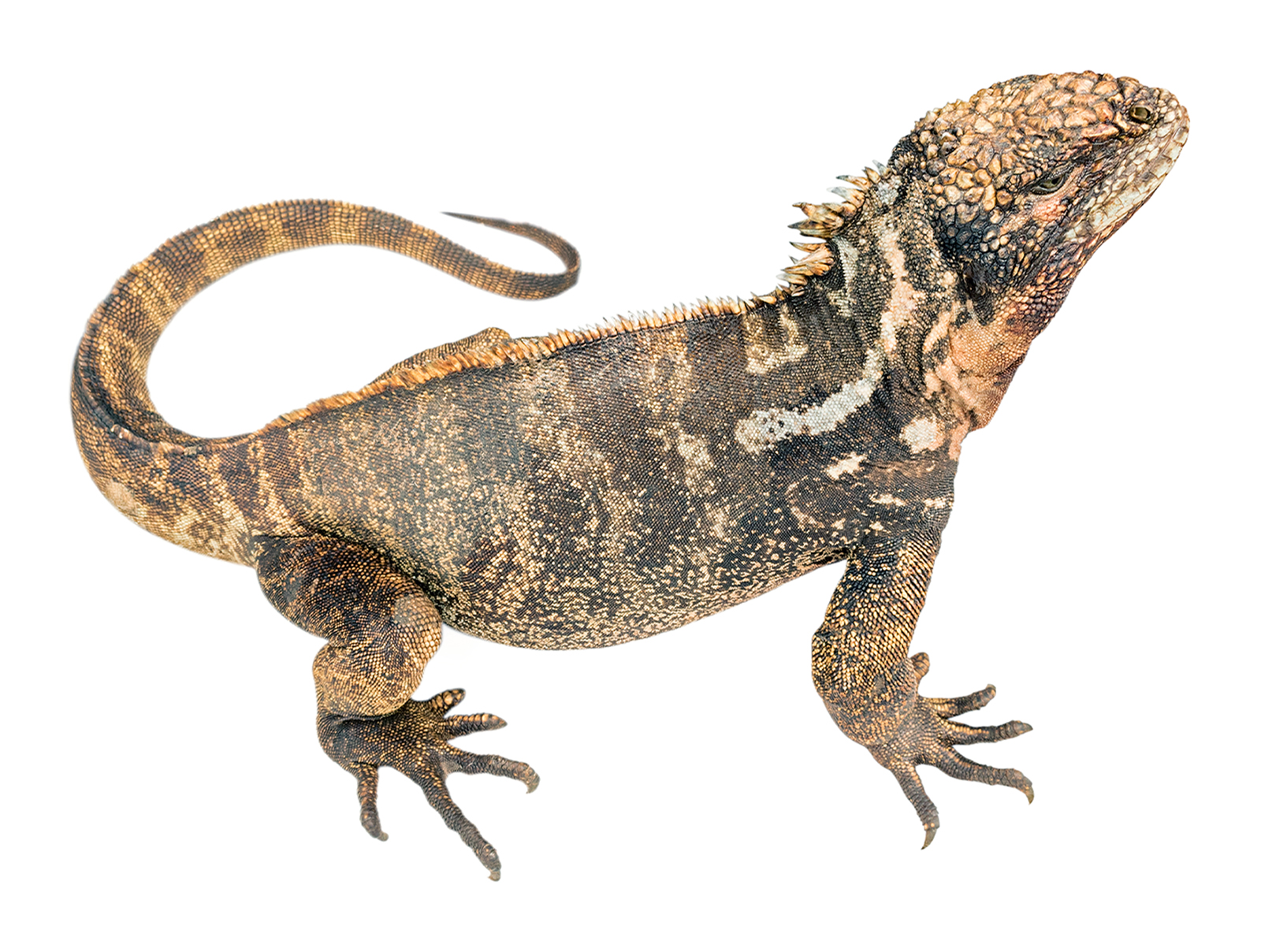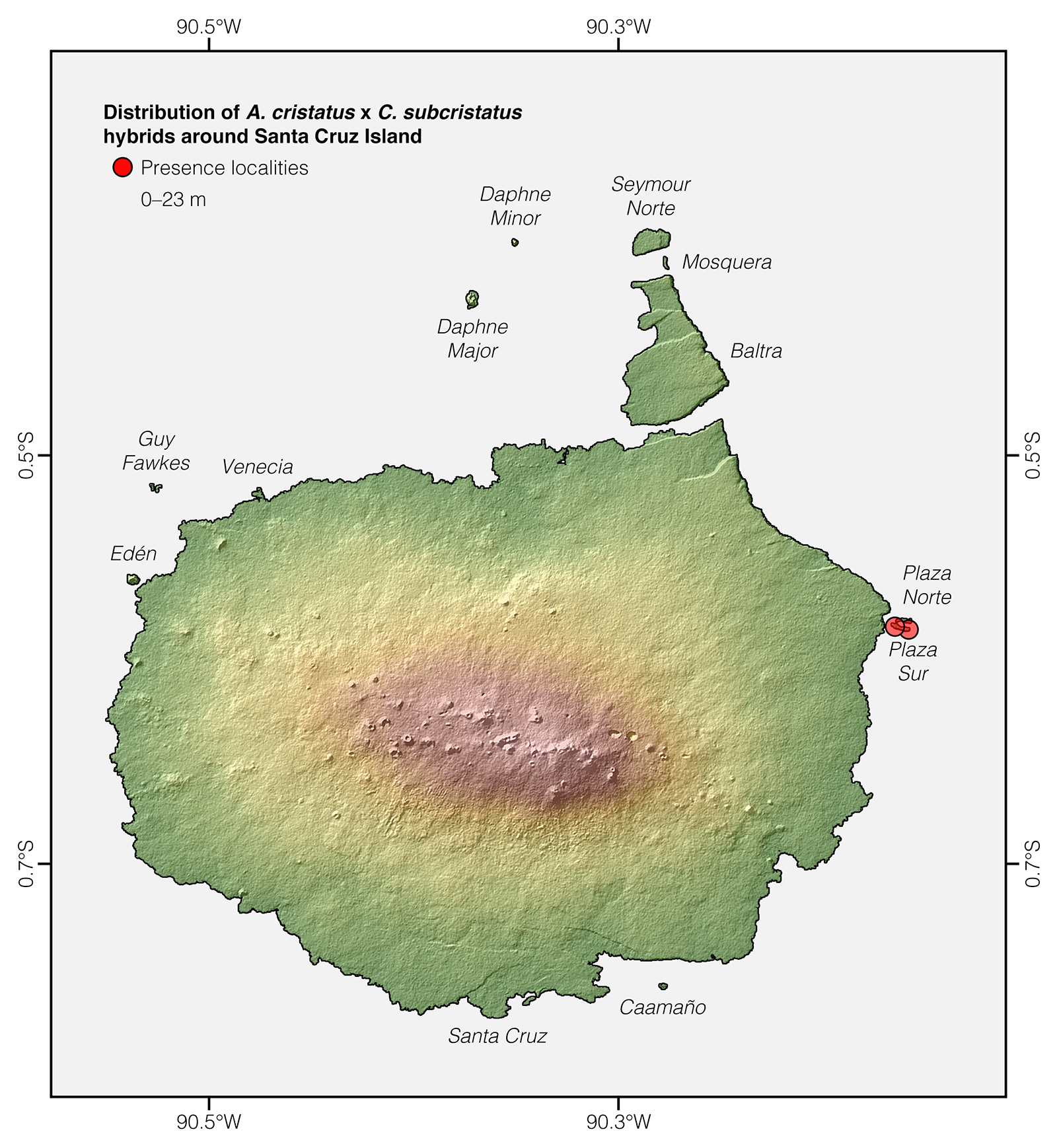Hybrid Iguana |
Reptiles of Ecuador | Sauria | Iguanidae | Amblyrhynchus cristatus x Conolophus subcristatus
Spanish common names: Híbrido, iguana híbrida.
Recognition: ♂♂ 95.5 cm. The Hybrid Iguana is a first-generation hybrid between a male Marine Iguana (Amblyrhynchus cristatus) and a female Galápagos Land-Iguana (Conolophus subcristatus).1 Hybrids are the only iguanas on Plaza Sur Island that have a laterally compressed tail but lack a blunt snout. Unlike their progenitors, hybrids may have a banded dorsal pattern and a whitish horizontal stripe behind the head.
Picture: Adult male. Plaza Sur Island. Galápagos, Ecuador. | |
 | |
Natural history: Extremely rare. Only six Hybrid Iguanas are believed to exist in Plaza Sur Island as of 2019. The hybrids are diurnal, terrestrial, and they inhabit dry grasslands and rocky outcrops,2 where they live side by side with Marine Iguanas (Amblyrhynchus cristatus) and Galápagos Land-Iguanas (Conolophus subcristatus). Hybrid Iguanas feed mostly on herbs, shrubs, flowers, and pads of the giant prickly pear cactus.2 They may occasionally also feed on seaweed that is exposed on rocks.2 Hybrid Iguanas exist only on Plaza Sur Island probably because this small 0.13 km2 island is densely populated by both land (53 individuals/ha)3 and marine (49 individuals/ha)4 iguanas that frequently come in contact with one another along the coastline. In other islands, Galápagos Land-Iguanas are usually found further inland. Hybrids between the land and the marine iguanas are believed to be sterile. Based on anecdotal information, their estimated maximum lifespan is 8–10 years.
Conservation: The Hybrid Iguana is not a species; thus, it is not the target of conservation actions. Therefore, the Galápagos National Park is not taking actions to increase or decrease the number of Hybrid Iguanas on Plaza Sur. Since the iguanas live on a small island that is free of exotic predators, the number of hybrids there has remained relatively constant (2–10 individuals) over the past 42 years.5
Distribution: Hybrid Iguanas have only been found on Plaza Sur, a 0.13 km2 island off the northeastern coast of Santa Cruz Island. Galápagos, Ecuador.


See it in the wild: The hybrids between Amblyrhynchus cristatus and Conolophus subcristatus can be seen with ~10% certainty during tourism day trips to Plaza Sur Island. The hybrids can be seen most easily near the visitor site's dock and on the northwest of the island.
Authors: Alejandro ArteagaaAffiliation: Fundación Khamai, Reserva Arlequín, Ecoruta Paseo del Quinde km 56, Santa Rosa de Mindo, Pichincha 171202, Ecuador.
Academic reviewer. Miguel Vences.
Photographers: Jose VieiraaAffiliation: Tropical Herping (TH), Quito, Ecuador.,bAffiliation: ExSitu, Quito, Ecuador.
How to cite? Arteaga A (2020) Amblyrhynchus cristatus x Conolophus subcristatus hybrid. In: Arteaga A, Bustamante L, Vieira J (Eds) Reptiles of Ecuador: Life in the middle of the world. Available from: www.reptilesofecuador.com
Literature cited:
- Rassmann K, Trillmich F, Tautz D (1997) Hybridization between the Galápagos land and marine iguana (Conolophus subcristatus and Amblyrhynchus cristatus) on Plaza Sur. Journal of Zoology 242: 729–739.
- Field notes, Reptiles of Ecuador book project.
- Tzika AC, Rosa SFP, Snell HL, Snell HM, Márquez C, Tapia W, Rassmann K, Gentile G, Milinkovitch MC (2008) Population genetics of Galápagos land iguana (genus Conolophus) remnant populations. Molecular Ecology 17: 4943–4952.
- Snell HL, Christian KA (1985) Energetics of Galápagos land iguanas: a comparison of two island populations. Herpetologica 41: 437–442.
- Goldman JG (2016) There is a hidden iguana on the Galápagos and nobody noticed. Available from: www.bbc.com